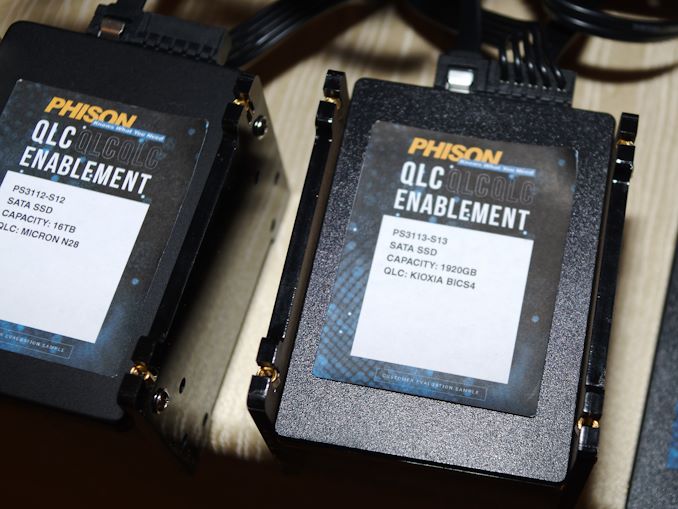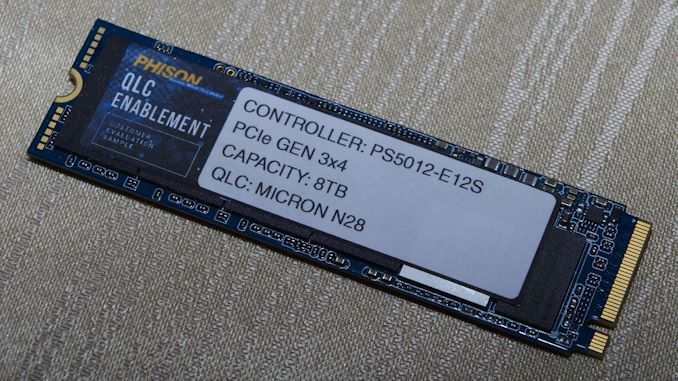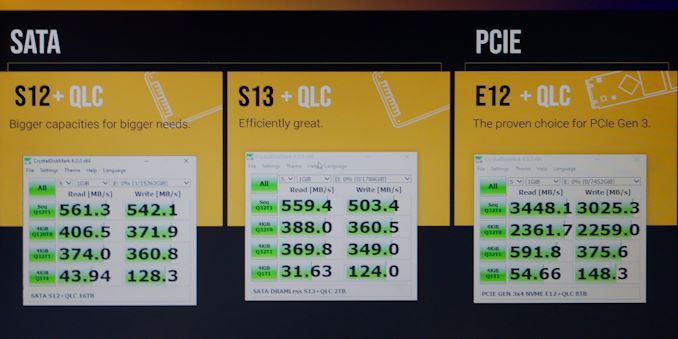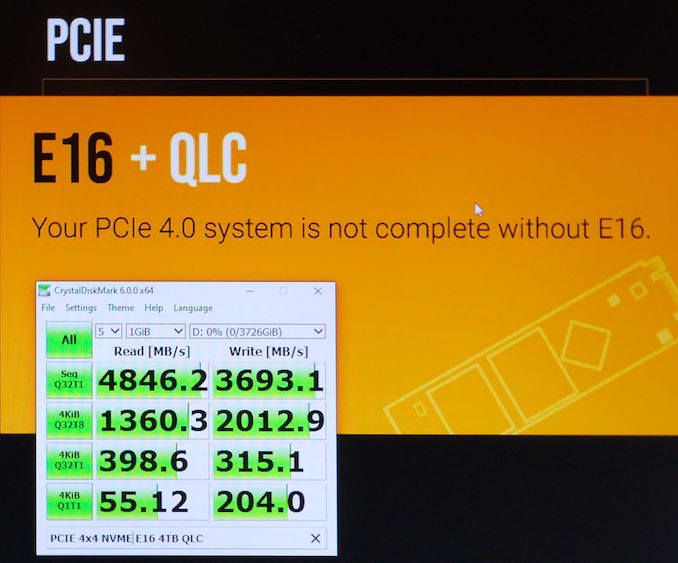Phison At CES 2020: Preparing For QLC To Go Mainstream
by Billy Tallis on January 17, 2020 11:00 AM EST
NAND flash memory prices are projected to climb in 2020. The manufacturing transitions to 96-layer 3D NAND and beyond are not going to increase bit output as quickly as demand will be growing. This will be a major change from the NAND oversupply that caused price crashes in 2018 and into 2019.
SSD controller vendor Phison is betting that increasing prices will finally push the consumer SSD market to embrace 4 bit per cell QLC NAND flash memory, which thus far has seen only limited success in the retail SSD market and virtually no adoption from PC OEMs. The price premium for SSDs with 3 bit per cell TLC NAND has been small or non-existent across all market segments, so the performance and endurance advantages of sticking with TLC NAND have been worthwhile. Those days may be coming to an end. Phison expects—quite reasonably—that when NAND flash memory supplies are constrained the bulk of the TLC NAND manufactured will be snatched up by the higher-paying enterprise SSD customers, more or less forcing the consumer SSD market to start shifting toward using QLC as the mainstream option.
In preparation for this shift, Phison is making sure that their full controller lineup is ready to work with QLC NAND. That means tuning the controller firmware to make the best of the lower performance of TLC NAND. For the OEM market in particular, they also have to update any of the older controllers whose error-correction capabilities aren't up to the task of supporting a 5-year warranty with the lower endurance of QLC.
Phison's hardware roadmap hasn't changed significantly from what we reported on after Flash Memory Summit. What is changing is how these controllers are being marketed. Phison has taken the unusual step of publishing performance specifications for most of their SSD controllers when paired with QLC NAND, rather than sticking with the TLC-based numbers that cast their controllers in a better light. Unfortunately, we're still getting numbers that are mostly based on testing at high queue depths and with durations short enough that the SLC cache is primarily what's being measured.
When paired with QLC NAND, Phison's high-end NVMe controllers will now be using a full-range dynamic SLC cache size, similar to what we've seen with recent Silicon Motion controllers but quite different from how existing TLC-based Phison NVMe drives have behaved with small fixed-size SLC caches. Maximizing the SLC cache size reduces the odds of ever running out of cache during ordinary consumer use, but at the cost of a more drastic performance penalty when the cache does fill up: there's more SLC data that needs to be compacted into TLC/QLC, and less free TLC/QLC to work with when doing that compaction in the background while continuing to handle host IO commands. This tradeoff makes the most sense when using QLC NAND, because no matter how big or small the SLC cache is, things will be painfully slow should it ever run out.
| Phison NVMe SSD Controller QLC NAND Projected Performance |
|||||||||||
| E12 | E16 | ||||||||||
| Host Interface | PCIe 3.0 x4 | PCIe 4.0 x4 | |||||||||
| NAND Channels, Interface Speed | 8 ch, 667 MT/s |
8 ch, 800 MT/s |
|||||||||
| Capacity | 1 TB | 2 TB | 4 TB | 8 TB | 1 TB | 2 TB | 4 TB | ||||
| SLC Cache Size | Dynamic | Dynamic | |||||||||
| Sequential Read | 3.4 GB/s | 4.7 GB/s | 4.9 GB/s | ||||||||
| Sequential Write | 2.0 GB/s | 3.0 GB/s | 1.9 GB/s | 3.8 GB/s | |||||||
| 4KB Random Read IOPS | 130k | 255k | 490k | 170k | 330k | ||||||
| 4KB Random Write IOPS | 500k | 680k | 480k | 800k | |||||||
The performance of Phison's current high-end NVMe controllers with QLC NAND will be quite a bit slower than the best achievable performance with TLC NAND. The reduction in random read performance will probably have the greatest impact. This is also where we see a requirement for much higher drive capacities in order to attain the best performance. Over the past two years, 1TB TLC-based SSDs have become quite affordable and are almost always large enough to offer the maximum performance a SSD controller can handle. If those price points have to switch over to QLC NAND this year, we'll see 1TB drives at a significant disadvantage compared to 2TB and 4TB models. Since NAND price increases will make it harder for consumers to jump up to higher capacities, we may see a real performance regression for the average mainstream consumer SSD, without any monetary savings as a consolation prize.
| Phison SATA SSD Controller QLC NAND Projected Performance |
||||||||
| S13T | S12 | |||||||
| DRAM | No | Yes | ||||||
| Capacity | 480 GB | 960 GB | 1920 GB | 1 TB, 2 TB, 4 TB, 8 TB, 12 TB, 16 TB | ||||
| SLC Cache Size | 9 GB | 18 GB | 36 GB | Dynamic | ||||
| Sequential Read | 550 MB/s | 550 MB/s | ||||||
| Sequential Write | 430 MB/s | 490 MB/s | 500 MB/s | 530 MB/s | ||||
| 4KB Random Read IOPS | 35k | 65k | 90k | 95k | ||||
| 4KB Random Write IOPS | 75k | 85k | 90k | 90k | ||||
Over on the SATA side, things don't look so bad. With the current S12 mainstream SATA controller and the full-range dynamic SLC caching strategy, even 1TB of QLC is still sufficient to hit the highest top-line performance numbers possible behind a 6Gbps bottleneck. Phison is listing those same peak performance numbers for capacities from 1TB all the way up to 16TB, including the non-power of two intermediate capacity of 12TB. In the past, those higher capacities have been supported only for the sake of enterprise SSDs, but Phison says they have at least one partner planning to bring out a 16TB drive for the consumer/prosumer retail market.
Phison's latest DRAMless SATA controller (S13T) will still be using fixed-size SLC caches when paired with QLC NAND, and low-cost drives that have to offer lower capacities will be stuck with subpar performance—again with random reads suffering the most.
Phison did not provide QLC-based performance projections for their current E13T DRAMless NVMe controller or its upcoming replacement E19T that brings PCIe 4.0 support and other performance increases. They also didn't provide QLC performance for the E18 (their 12nm second-generation high-end PCIe 4.0 controller), but that controller is due much later in the year and it should still be used mostly with TLC for enthusiast-class drives, unless the NAND price situation gets really bad.
As usual for performance projections from SSD controller vendors, the numbers are subject to change between now and retail availability of drives. The choice of which particular QLC NAND is used in a given product will affect performance, and there's still time for further firmware optimizations.
At CES 2020, Phison demonstrated various combinations of QLC NAND with their controllers in a range of capacities. Most of the SSDs shown were using Micron 96L QLC, but a few were also using Toshiba/Kioxia BiCS4 (96L) QLC. The QLC preparations also carried over to Phison's portable storage products, where they showed a 1TB MicroSD card, an 8TB Thunderbolt 3 SSD, and several USB attached solutions. All of these reference designs are likely to come to market this year, and in the portable storage market the QLC transition will probably be more thorough and unavoidable.



















10 Comments
View All Comments
Unashamed_unoriginal_username_x86 - Friday, January 17, 2020 - link
Annoying market trend is annoying. I suppose the prospect of higher capacities is what matters to Average Joe and will help SSDs push hdd out of some markets a bit better, but I miss watching the esoteric numbers go up );shabby - Friday, January 17, 2020 - link
As long as the $$$ numbers go down i don't mind, even the slowest e12 has good enough numbers for majority of people.peevee - Friday, January 17, 2020 - link
"we'll see 1TB drives at a significant disadvantage compared to 2TB and 4TB models. Since NAND price increases will make it harder for consumers to jump up to higher capacities, we may see a real performance regression for the average mainstream consumer SSD, without any monetary savings as a consolation prize."With current prices, and future QLC prices, it does not make sense to buy anything smaller than 2TB anyway.
peevee - Friday, January 17, 2020 - link
I have a couple of questions about the table posted.1. Why E16-based drives do not have 8TB models, while E12 do?
2. Why E12 has higher random read performance @ 4TB (490k) than E16 (330k), while @ 1TB and 2TB E16 is faster as expected?
Billy Tallis - Friday, January 17, 2020 - link
1. They probably don't have any customers planning to do an 8TB E16 drive in the near future, but they definitely have customers doing 8+ TB E12 drives (albeit not for the consumer retail market). Those customers may not be ready to switch to PCIe 4.0, or may be waiting for E18.2. This is probably a mistake on Phison's part, because the E16 is definitely the faster controller. They even have at least one customer using E16 at PCIe gen3 speed (ie. with PCIe gen4 disabled in firmware) because E16 is a bit faster and has better LDPC. My guess is that they either didn't test the larger E12 and E16 QLC drives the same way, or they simply printed the wrong numbers in their CES brochure. I'm pretty sure that they aren't using a drastically different firmware between the two.
Chris_Ramseyer - Friday, January 17, 2020 - link
Hello peevee,The E12 was tested on an Intel platform and the E16 tested on AMD. There are subtle differences between the two platforms that make the direct comparisons difficult. The E16 is faster than the E12 on Intel.
CR - Representing Phison
austinsguitar - Friday, January 17, 2020 - link
yea yea yea but what is the endurance phison :). gonna need to know that "tiny" bit of information rather soon.AlexDaum - Sunday, January 19, 2020 - link
The endurance dies not depend on the controller, but on the Flash chips used, so it doesn't make sense for phison to specify endurance, since the controller can be paired with flash from different manufacturers, that have different endurance. But you can expect QLC endurance to be a lot less than TLC.austinsguitar - Sunday, January 19, 2020 - link
you are very right my guy <3. The only problem i have is that these controllers are tailored towards QLC drives. It will be some time before QLC drives have enough endurance for nas use. for common people like me this "isnt" a problem at all. :) but 2TB QLC right now having endurance numbers of 600TBW endurance isn't aw inspiring. and that's the best we got right now. compare that to 4x or more endurance numbers of TLC right now. I understand it will get better with time. I think in about a year we will see competent endurance from QLC drives.PaulHoule - Wednesday, January 22, 2020 - link
It almost seems like the SSD industry is desperate to produce SSD drives with real-world performance worse than HDD.QLC looks like a clear losing proposition. Going from 3 bits per cell to 4 bits per cell gives only a 25% improvement in capacity, but the problem of discriminating that many voltage levels is vastly greater. If they are going to more bits per cell, it just gets worse.
Why?